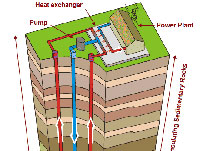
Hot Prospect - Geothermal Electricity
in East African Rift Valley
Dec 11, 2008 - iNS/news/net
A century-old energy technology that taps steam from
hot underground rocks is poised for a massive expansion
up East Africa's Rift Valley in the 21st century.
The news comes as countries across the world, from
Guatemala to Papua New Guinea, are beginning to plug
into geothermal energy as a new and promising alternative
to coal and oil-fired power generation. Last Tuesday,
the United Nations Environment Programme (UNEP) and
the Global Environment Facility (GEF) announced the
completion of project testing advanced seismic and
drilling techniques in Kenya that has exceeded all
expectations.
Wells of steam, able to generate 4-5 MW of electricity
and one yielding a bumper amount of 8 MW, have been
hit using the new technology. It could mean a saving
of as much as $75 million for the developer of a 70
MW installation as well as reduced electricity costs
for generators and consumers, experts estimate.
The results, announced at the UN Framework Convention
on Climate Change in Poznan, Poland have now paved
the way for an international effort in 2009 to expand
geothermal up and down the Rift which runs from Mozambique
in the South to Djibouti in the North. The project,
funded by the GEF and involving UNEP and the Kenyan
power company KenGen, could also transform the prospects
and costs for geothermal elsewhere in the world.
Achim Steiner, UN Under-Secretary General and UNEP
Executive Director, said: "Combating climate change
while simultaneously getting energy to the two billion
people without access to it are among the central
challenges of this generation. Geothermal is 100 per
cent indigenous, environmentally-friendly and a technology
that has been under-utilized for too long".
"There are least 4,000 MW of electricity ready for
harvesting along the Rift. It is time to take this
technology off the back burner in order to power livelihoods,
fuel development and reduce dependence on polluting
and unpredictable fossil fuels. From the place where
human-kind took its first faltering steps is emerging
one of the answers to its continued survival on this
planet," he added.
Monique Barbut, Chief Executive Officer and Chairperson
of the GEF, said: "Overcoming the economic and technical
hurdles to renewable energy generation is part of
our shared responsibility. The work in the Rift Valley
is demonstrating that geothermal is not only technologically
viable but cost effective for countries in Africa
where there is an overall potential of at least 7,000
MW".
"Indeed geothermal world-wide is undergoing a renaissance
with the numbers of countries starting to use this
power source estimated to rise from around 20 in 2000
to close to 50 by 2010. Africa's Rift Valley will
I hope become a beacon for further geothermal acceleration
in terms of the size and the number of power plants
alongside its geographical spread across the developed
and developing world".
The Project in Kenya
The GEF-funded project has, over the past three years
used techniques known as Micro Seismic and Magneto
Telluric surveys and studies for identifying promising
new drilling sites at locations including Olkaria,
Naivasha which is around one hour's drive from the
capital Nairobi. Here a geothermal plant generating
45 MW has been operating for a quarter century. A
second plant was brought on stream in 2000 with a
capacity of 70 MW.
The main challenge to expansion in Kenya and elsewhere
along the Rift has been the risk associated with drilling
and the high costs if steam is missed. The nearly
$1million Joint Geophysical Imaging project has aimed
to overcome these risks. The old wells in Naivasha
generate about 2 MW whereas the new techniques have
not only boosted the chances of hitting steam but
have pinpointed wells of much higher potential, typically
on average 4 to 5 MW.
Rift Geothermal Expansion
Two years ago the GEF Council approved the Africa
Rift Valley Geothermal Development Facility (ARGeo)
backed with close to $18 million of funding and involving
UNEP and the World Bank. The project, which will underwrite
the risks of drilling in Djibouti, Eritrea, Ethiopia,
Kenya, Uganda and Tanzania, is now set to commence
in early 2009 and will be able to call on the equipment
and techniques piloted by KenGen and UNEP.
The ARGeo initiative has strong support from Iceland,
one of the world's leading geothermal economies where
well over 90 per cent of its electricity comes from
'hot rock' and hydro, as well as Germany which is
also developing this energy technology. Separately
Kenya and private investors are also seeking support
funding from the Clean Development Mechanism (CDM)
of the Kyoto Protocol for a further 35 MW extension
which is currently in the validation stage.
Kenya's current electricity capacity is around 1,000
MW. The country relies heavily on hydro-electric plants,
generation systems that have in recent years suffered
as a result of low rainfall and water supplies. The
country has set itself a goal of generating 1,200
MW from geothermal by 2015.
A contract has recently been awarded to a Chinese
company to drill as part of the development of a new
Olkaria IV plant. As a result of the UNEP-GEF Joint
Geophysical Imaging project the number of wells likely
to be needed to achieve 70 MW could be 15 versus over
30 using the previous technology. This could save
as much as $5 million for each well drilled.
UNEP-GEF is currently in discussions with the Ministry
of Water and Environment of Yemen to explore for geothermal
there in early 2009. More countries in the region
with geothermal resources have also signalled their
enthusiasm to participate in the geothermal expansion
including the Comoro Islands, the Democratic Republic
of the Congo and Rwanda. Source: UNEP

|



